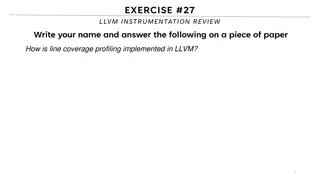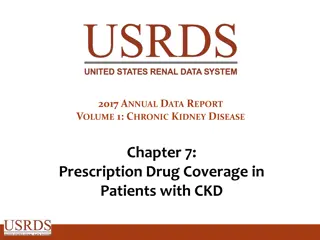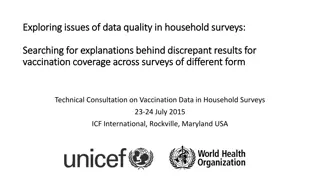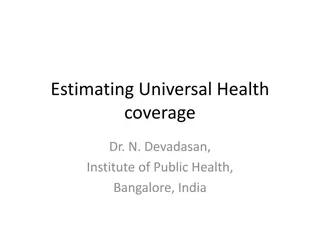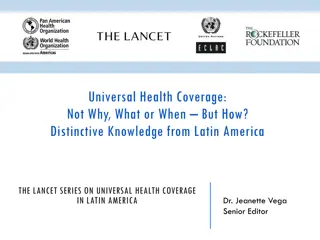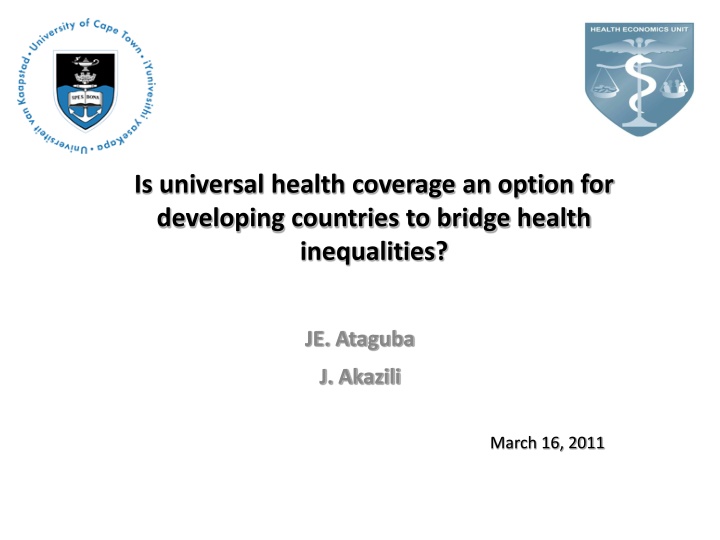
Universal Health Coverage for Health Inequalities: Cross-Country Analysis
This paper explores the importance of universal health coverage in addressing health inequalities across countries, focusing on the burden of disease borne by the poor and lower socio-economic groups. Using data from various health indicators, the study highlights the role of universal coverage in improving healthcare access and outcomes.
Download Presentation

Please find below an Image/Link to download the presentation.
The content on the website is provided AS IS for your information and personal use only. It may not be sold, licensed, or shared on other websites without obtaining consent from the author. If you encounter any issues during the download, it is possible that the publisher has removed the file from their server.
You are allowed to download the files provided on this website for personal or commercial use, subject to the condition that they are used lawfully. All files are the property of their respective owners.
The content on the website is provided AS IS for your information and personal use only. It may not be sold, licensed, or shared on other websites without obtaining consent from the author.
E N D
Presentation Transcript
Is universal health coverage an option for developing countries to bridge health inequalities? JE.Ataguba J. Akazili March 16, 2011
Introduction Health Economics Unit, University of Cape Town Within countries, the poor and lower socio-economic groups (SEGs) are notable to bear a greater burden of disease more from communicable diseases South Africa To what extent is this reflected across countries?
Objectives Health Economics Unit, University of Cape Town This paper conducts a cross-country analysis to examine the extent of socio- economic related health inequalities South Africa In the light of these explores the importance of universal coverage in redressing health inequalities
Methods Health Economics Unit, University of Cape Town Secondary datasets World bank databank (http://databank.worldbank.org) Data at country level Health system variables (health worker density), Public health variables (Diabetes, HIV, TB, measles) Population health variables (e.g. IMR, MMR, malnutrition undernourishment) Individual/health system variables (immunisation coverage, place of delivery) Cause of death (TB, Injury, communicable, and NCDs) Latest year for which reasonably large data points are available is used for each condition Socioeconomic status (SES) of a country is measured as per capita GNP South Africa
Methods [2] Health Economics Unit, University of Cape Town Analytical method Concentration indices (and curves) Dominance tests The concentration index theoretically lies between 1 and +1 (CI = 1) when all the population s ill-health or disability is concentrated in the hands of the most disadvantaged person South Africa (CI = +1) when all the population s ill-health or disability is concentrated in the hands of the least disadvantaged person Generally, A positive (negative) index signifies that the distribution of ill health is more among the richer (poorer) SES groups
Health Economics Unit, University of Cape Town Results South Africa
Individual/Health systems variables Health Economics Unit, University of Cape Town . . Birth not attended by health worker Not immunised (BCG) Not immunised (HEP-B3) Not immunised (DPT) Not immunised (Polio) 0 D D D D -0.1 D South Africa -0.2 Concentration index -0.3 -0.4 -0.5 -0.6 -0.7 -0.8 -0.9
Health Systems variables Health Economics Unit, University of Cape Town . 0.7 . 0.6 0.5 Concentration index South Africa 0.4 0.3 0.2 0.1 D2 D2 D2 0 Health worker density Physician density Nurses density
Publichealth variables Health Economics Unit, University of Cape Town . . TB prevalence Diabetes Measles HIV female HIV prevalence 0.2 0.1 0 South Africa Concentration index D -0.1 D -0.2 -0.3 -0.4 -0.5 -0.6
Populationhealth variables Health Economics Unit, University of Cape Town . 0.6 . Maternal mortality Undernourishment Infant mortality Under-weight 0.4 Stunting 0.2 D2 D2 South Africa Concentration index 0 D Overweight (female) D D D D Overweight (male) -0.2 -0.4 -0.6 -0.8 -1 Infant mortality Underweight Undernourishment Overweight (M) Overweight (F) Stunting Maternal mortality
Causes of death Health Economics Unit, University of Cape Town . . 0.3 0.2 0.1 D2 Concentration index 0 South Africa -0.1 D D -0.2 -0.3 -0.4 -0.5 -0.6 Death due to TB Death due to non- communicable diseases Death due to communicable diseases Death due to injury
Results - Summary Significant correlations exist the burden of ill-health, disease and deprivation is inversely related to a county s per capita income poorer countries bear a greater burden of global disease particularly in communicable than NCDs Richer countries bear a greater burden of over- weight while poorer countries bear a greater burden of mal- and under-nutrition. Reflective of poverty versus affluence! Maldistribution of health care workers across countries More health care workers per capita in developed countries compared to poorer and developing countries. Health Economics Unit, University of Cape Town South Africa
Individual/health systems variables Health Economics Unit, University of Cape Town Immunisation issues: Parents preference for errors of omission to errors of commission (Fredrickson et al., 2004) i.e. they are more inclined to accepting natural risks rather than man-made risks Compulsory vaccination is often viewed as an unnecessary infringement on individual rights of freedom (Ross & Aspinwal, 1997) Religious/philosophical belief that the disease is not harmful Cultural and political reasons Misinformation and lack of information South Africa Facility based delivery issues: - also similar Affordability?? What role is there for the government (and the health systems)?
Public and population health variables Two disease patterns the diseases of poverty (i.e. those that are concentrated among the poorer countries (Lee et al., 2002) The diseases of affluence or lifestyle (i.e. those that are concentrated amongst richer countries) Diseases of poverty are related to socio-economic factors Can be addressed through the social determinants of health Diseases of affluence are related to lifestyle need to address the major associated risk factors and change in life style Health Economics Unit, University of Cape Town South Africa
Public and population health variables Major causes of death are correlated with a country s income level Burden of communicable diseases higher in developing countries NCDs more among richer countries However by 2020, NCDs will be become implicated in seven out of every ten deaths in developing countries (WHO, 2002) Health Economics Unit, University of Cape Town South Africa Major population health variables are correlated with a country s level of income Richer countries overweight Poorer countries malnutrition, stunting, undernourishment, etc. Again these are linked to the wider social determinants of health issues and lack of adequate financial risk protection
Health systems variables Health Economics Unit, University of Cape Town Disease burden Health workers Where are the health workforce concentrated? South Africa Poorer countries Where do we have greater burden of diseases? Richer countries
Any role for universal coverage? A well planned and initiated universal coverage system for poorer countries is very important It is likely to redress the health inequality across countries Health Economics Unit, University of Cape Town However, it is more than just health and health care! South Africa Improvements in other sectors that complement health are relevant E.g. case of immunisation coverage The combination of strategies, within countries, that recognizes the wider sphere of social determinants of health is important in reducing cross country health inequalities
Conclusion To achieve universal coverage, and redress the existing health inequalities the preparedness of the public sector and public support are also very important Health Economics Unit, University of Cape Town South Africa An integrated approach is needed drawing on the potential gains of universal coverage, health systems restructuring, public support and complemented with programmes that address social determinants of health is relevant in redressing existing inequalities across countries.
Health Economics Unit, University of Cape Town Thank you for your attention South Africa







